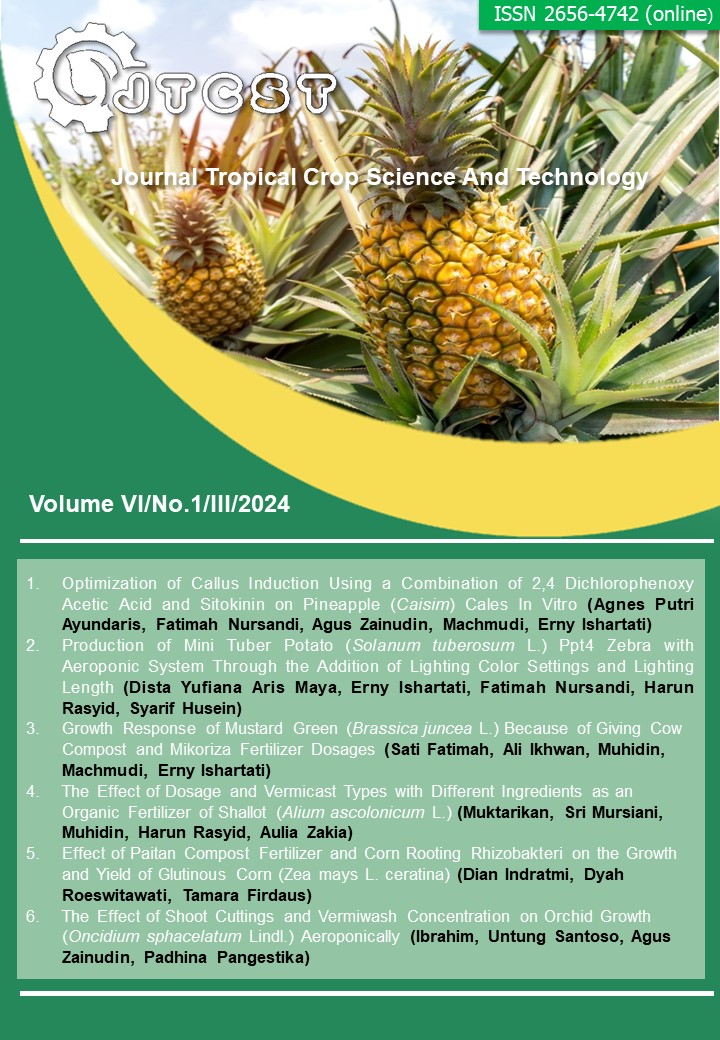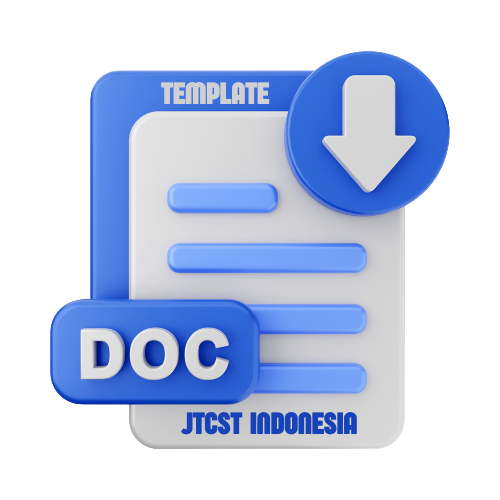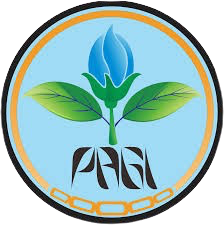Growth Response of Mustard Green (Brassica juncea L.) Because of Giving Cow Compost and Mycorrhiza Fertilizer Dosages
DOI:
https://doi.org/10.22219/jtcst.v6i1.32894Keywords:
Dosage Cow Compost, Mustard Growth, MikorizaAbstract
Mustard green (Brassica juncea L.) is a leafy vegetable with a subtropical climate, but this plant can adapt well to tropical climates that it suitable to be planted and grow in Indonesia. The formulation of problem in this study is to lessen the use of chemistry fertilizer in fertilization on plants, especially mustard green (Brassica juncea L.). This study aims to review the growth response of mustard green (Brassica juncea L.) because of the dosage of cow compost and mycorrhiza fertilizer dosages. This study used a randomized block design (RBD) arranged in a split plot with 2 factors. The first factor as main block of cow compost dosage consists of three levels, they are 2,5 tons/ha, 5 tons/ha, and 10 tons/ha. The second factor is offspring block, a mycorrhiza dosage consisting of three levels: 1 tablet/plant, 2 tablets/plant, and 3 tablet/plant, each repeated 3 times. Observed variables are plant height, the number of leaves, leaf wide, fresh weight and dried weight of the plant, fresh and dried weight, fresh and dried ratio of root weight, and dried crown weight. The result of this study shows that there is no interaction between giving cow compost and mycorrhiza dosage toward mustard green height, fresh weight and dried weight, fresh and dried ratio of root weight and dried crown weight, but separately dosing cow manure 2.5 ton/ha can increase broad leaf mustard plants at 2 weeks after planting and dosage, as well as mycorrhiza 1 tablet/plants and 2 tablets/plant, has been able to increase leaf area from age 2 weeks after planting.Downloads
References
Abbot, L.K. dan Robson, A.D., 1984. The Effect of Mycorrhizae on Plant Growth. CRC Press, Inc. Boca Raton. Florida.
Anonim, 2011a. Vesikel. (online). http:// id.wikipedia.org/wiki/vesikel.
Diakses pada tanggal 16 Mei 2015
——— 2011b. Arbuskul. (online). http://wordpress.com/2011/08/14
Diakses pada tanggal 16 Mei 2015
——— 2012. Spora. Penerbit penebar swadaya. Jakarta.
Bara A., M. A. Chozin. 2009. Pengaruh Dosis Pupuk Kandang Dan Frekuensi Pemberian Pupuk Urea Terhadap Pertumbuhan Dan Produksi Jagung (Zea Mays L) Di Lahan Kering. Makalah Seminar Departemen Agronomi dan Hortikultura Fakultas Pertanian Institut Pertanian Bogor.
Cahyono, B. 2003. Teknik dan Strategi Sawi Hijau (Pat-Tsai). Yayasan Pustaka Nusantara. Yogyakarta.
Daniels, B.A. dan J.M. Trappe. 1980. Factors Affecting Spore Germination of The Vesicular-Arbuscular Mycorrhizal Fungus, Glomus epigaeus. Mycologia 72:457-471.
Dewi, R.I. 2007. Makalah Peran, Prospek dan Kendala dalam Pemanfaatan Endomikoriza. Fakultas Pertanian. Universitas Padjadjaran. Bandung
Direktorat Gizi. 1979. Kandungan Gizi dalam 100 g Sawi. Departemen Kesehatan RI.
Elfiati, D. dan Delvian. 2007. Keanekaragaman Fungi Mikoriza Arbuskula Berdasarkan Ketinggian Tempat. Jurnal Ilmu-Ilmu Pertanian Indonesia.3:371-378.
Fahrudin F, 2009. Budidaya Caisim (Brassica juncea L.) Menggunakan Ekstrak Teh dan Pupuk Kascing. Skripsi. Fakultas Pertanian. Universitas Sebelas Maret. Surakarta.
Fahn, A. 1982 Diterjemahkan oleh Soediro, A. 1991. Anatomi Tumbuhan.
Gadjah Mada University Press. Yogyakarta.
Fitter, A.H. dan R.J.M. Hay.1994. Fisiologi Lingkungan Tanaman. Gajah Mada University Press. Yogyakarta.
Gardner, F.P., R.B. Pearce dan R.L. Mitchell. 1991. Fisiologi Tanaman Budidaya. UI Press. Jakarta.
Gunawan. 1993. Produktivitas dan Nilai Ekonomis. Kanisius, Yogyakarta.
Hanafiah A. S, T Sabrina & H Guchi, 2009. Biologi dan Ekologi Tanah. Universitas Sumatera Utara. Medan.
Hanolo, W. 1997. Tanggapan Tanaman Selada dan Sawi Terhadap Dosis dan Cara Pemberian Pupuk Cair Stimulan. Jurnal Agrotropika
Haris, S. 2005. Jurnalistik Indonesia, Menulis Berita dan Feature, Panduan Praktis Jurnalis Profesional. Penerbit PT. Remaja Rosdakarya Bandung.
Haryanto E. T, Suhartini E, Rahayu, dan H. H Sunarjono, 2006. Sawi dan Selada. Penebar Swadaya. Jakarta. 112 p.
Havlin, J. L., J. D. Beaton, S. L. Tisdale, and W. L. Nelson. 2005. Soil Fertility and Fertilizers: An Introduction to Nutrient Management. Pearson Prentice Hall, New Jersey. p213 214.
Husin E. F, 1997. Respon beberapa jenis tanaman terhadap mikoriza vesikular arbuskular dan pupuk fosfat pada ultisol. Di dalam prosiding pemanfaatan cendawan mikoriza untuk meningkatkan produksi tanaman pada lahan marginal. Asosiasi Mikoriza Indonesia, Universitas Jambi.
Janouskova, M., D. Pavlikova, dan M. Vosatka. 2006. Potential Contribution of Arbuscular Mycorrhiza to Cadmium Immobilization in Soil. Chemosphere 07. 007
Lakitan, B. 2004. Dasar-Dasar Fisiologi Tumbuhan. PT. Raja Grafindo Persada. Jakarta.
Landecker, E. M., 1982. Fundamental of Fungi. Prentice Hall Inc, Engelwood Cliffs, New Jersay. p. 73.
Lukitawati, D. R. 2011. Penerapan Bioteknologi Mikoriza untuk Peningkatan Produksi dan Kualitas Hijauan Pakan. Pidato Pengukuhan Guru Besar Fakultas Peternakan, Universitas Diponegoro, Semarang.
Maas, E.V., dan R.H. Nieman. 1978. Physiology of Plant Tolerance to Salinity. Dalam G.A. Jung (Ed). Crop Tolerance to Suboptimal Land Conditions. ASA Spec. Pub. 277-299.
Maftuchah dan S. Idiyah, 2002. Pedoman Analisa Pertumbuhan Tanaman. Universitas Muhammadiyah Malang. Malang
Mangkunegara A, (2005). Perilaku Konsumen. Edisi Revisi. Refika Aditama, Bandung.
Martoyo, K. 2001. Penanaman Beberapa Sifat Fisik Tanah Ultisol pada Penyebaran Akar Tanaman Kelapa Sawit. PPKS. Medan.
Mosse B, 1981. Vesicular-arbuscular mycorrhizal research for tropical Agriculture. Res. Bull. 82p.
Nurbaity A, A Setiawan dan O Mulyani, 2011. Efektivitas Arang Sekam Sebagai Bahan Pembawa Pupuk Hayati Mikoriza Arbuskula pada Produksi Sorgum. J Agrinimal 1(1): 1 -6.
Opena, R. T and D. C. S Tay. 1994. Brassica rapa L. Group Caisim. Hal 153-157. J. S. Simonsma dan K. Pileuk. Plant Resource of Sout-East Asia, Vegetable. PROSEA Foundation.
Pujianto. 2001. Pemanfaatan Jasad Mikro, Jamur Mikoriza dan Bakteri dalam Sistem Pertanian Berkelanjutan di Indonesia: Tinjauan dari Perspektif Falsafah Sains Program Pasca Sarjana Institut Pertanian Bogor. Bogor.
Rukmana, R. 2007. Bertanam Petsai dan Sawi. Kanisius. Yogyakarta.
Santoso E ; Turjan & Irianto R. SB. 2006. Aplikasi Mikoriza Untuk Meningkatkan Kegiatan Rehabilitasi Hutan dan Lahan Terdegradasi. Prosiding Ekspose Hasil-hasil Penelitian.
Sastra Hidajat, I.H dan Soemono. 1996. Budidaya Tanaman Tropika. Usaha Nasional, Surabaya.
Schenck, N.C, dan N.V. Schroder. 1974. Temperature Response of Endogone Mycorrhiza on Soybean Roots. Mycology: 600-605.
Setiadi, Y., 2001. Peranan Mikoriza Arbuskula dalam Reboisasi Lahan Kritis di Indonesia. Makalah Seminar Penggunaan Fungi mikoriza arbuskula dalam Sistem Pertanian Organik dan Rehabilitasi Lahan Kritis. 21-23 April 2001. Bandung.
Simanungkalit RDM, 2009. Cendawan Mikoriza Arbuskula. Makalah Ilmiah. http//Simanungkalit. Cendawan Mikoriza-Arbuskula/book/file. Diakses 24 September 2014.
Simanjuntak D, 2004. Manfaat Pupuk Organik Kascing Dan Cendawan Mikoriza Arbuskula (CMA) Pada Tanah dan Tanaman. Jurnal Penelitian Bidang Ilmu Pertanian Volume 2, Nomor 1, April 2004: 1-3
Suhardi, 1990. Dasar- dasar Bercocok Tanam. Kanisius, Yogyakarta.
Sudjijo, 1996. Dosis Pupuk Gandapan pada Tanaman Tomat Secara Hidroponik. Balai Penelitian Solok.
Sumarsono, 2001. Hasil hijauan setaria (Setaria splendida Staft) dalam pertanaman campuran dengan sentro (Centrosema pubescens) yang menerima pupuk fosfat dan kotoran ternak. J. Pengemb. Pet. Trop. Special Ed.: 129-136.
Sunaryono, H., Suwandi, A.H. Permadi, F. A. Bahar, S. Sulihanti, dan W. Broto. 1995. Teknologi Produksi Bawang Merah. Pusat Penelitian dan Pengembangan Hortikultura. Badan Penelitian dan Pengembangan Pertanian. Jakarta. Hlm.54.
Sutanto, 2002. Perbedaan Antara Pupuk Anorganik Dan Pupuk Organik. Fakultas Tanaman Jagung. J. BPTP Sumatera Utara. Medan.
Sutedjo, AY., 2009. Buku Saku Mengenal Penyakit Melalui Hasil Pemeriksaan Laboratorium. Yogyakarta: Penerbit Amara Books.
Turk MA, TA Assaf, KM Hameed dan AM Al-Tawaha, 2006. Significance of Mycorrhizae. World Journal of Agricultural Sciences 2(1): 16-20.
Downloads
Published
How to Cite
Issue
Section
License
Copyright (c) 2024 Sati Fatimah, Ali Ikhwan, Muhidin, machmudi, Erny Ishartati

This work is licensed under a Creative Commons Attribution-ShareAlike 4.0 International License.
Authors who publish with this journal agree to the following terms:
- Authors retain copyright and grant the journal right of first publication with the work simultaneously licensed under a Creative Commons Attribution License that allows others to share the work with an acknowledgement of the work's authorship and initial publication in this journal.
- Authors are able to enter into separate, additional contractual arrangements for the non-exclusive distribution of the journal's published version of the work (e.g., post it to an institutional repository or publish it in a book), with an acknowledgement of its initial publication in this journal.
- Authors are permitted and encouraged to post their work online (e.g., in institutional repositories or on their website) prior to and during the submission process, as it can lead to productive exchanges, as well as earlier and greater citation of published work (See The Effect of Open Access).











